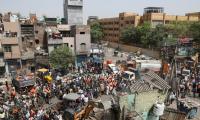care of by that institution is what really matters. Is there any doubt that we continued with British colonial practices in our institutions and that even today more than 85 percent of the military strength belongs to Punjab?
Likewise, is it fair that due to either lopsided investment or a lack of investment in educating the local population of Balochistan for decades, many government officials, military officers or judges who come in service streams from Balochistan really hail from Punjab? I know these trends are shifting but one, a lot of damage is done already and two, even now the pace for changing this is much slower than it should be.
Equitable distribution and ownership of resources remains an issue between the provinces because it is not only about direct allocation for Punjab, but a much larger share for the federation instead of provinces is also seen as mostly going to Punjab. Ironically, Punjab did not want the resources to be distributed among the provinces on the basis of population when East Pakistan was a part of the republic until 1971. Since then it does. As a result, there is a complete mistrust between the provinces.
The Kalabagh dam is also a case in point. Essentially, it is that deep mistrust between Punjab, Khyber Pakhtukhwa and Sindh that stops the project before it takes off. What is this mistrust rooted in? One answer is that in the past, Sindh – which is the lower riparian – was informed of a season canal to be taken out of an earlier barrage. Sindh agreed. Later on, the canal was turned into a perennial canal and used water from the share of the lower riparian.
Punjab is seen as oppressive, exclusionary and a usurper of other’s rights and resources. There are many tales that can be told, and arguments and counter arguments that can be made. By no means are elites from other provinces, particularly the Mohajir elite that treated Pakistan as a colony for so many years and thought of the common people in the country as sub-humans, absolved of what has gone wrong. But in today’s Pakistan, Punjab has a pivotal role to play if the federation has to survive and thrive. Particularly in the wake of a massively Punjabi-dominated political government in the federation, the responsibility on the Punjabi intelligentsia increases.
The way the federal government dealt with the formation of the provincial government in Balochistan is certainly a good beginning but does not suffice. Pakhtuns, Sindhis, Mohajirs, and the Baloch all have grievances. Are they all wrong? Were the Bengalis wrong too? So who is right then? But rather than issuing certificates of loyalty and disloyalty to other peoples and provinces, which the retired colonels and brigadiers from Punjab and a motley group of Punjabi columnists are most fond of doing in their conversations and writings even today – the intelligentsia at large being defensive and getting angry on correct and incorrect blames and accusations – Punjabis should take stock of what did not go right, introspect and capitalise on their own traditional values and cultural strengths.
Punjab’s anti-imperial, people-centred and historically inclusive character has to come out in the political realm as well. What a tragedy that Punjab, which has made the most contribution to a composite South Asian culture, not just Pakistani, is seen very differently in the politics of Pakistan. This must change and the change has to be led by the Punjabi intelligentsia itself. The real message from Punjab to the perpetrators of injustice, torchbearers of imperialism and upholders of colonialism that had come out over centuries can be seen in the struggles of people like Dulla Bhatti, Guru Gobind Singh and Bhagat Singh and the writings from our subversive Sufi poets to Faiz Ahmed Faiz, Amrita Pritam and Habib Jalib. They give a universal message of truth, humanity and freedom.
If we look at the development of the enlightened political movements, and progressive and socially informed literature, Punjab produced political workers, writers, poets, artists and thinkers who made significant contributions in their fields and participated in other movements that were wider in nature and scope. Their struggle went much beyond Punjab.
Faiz, for instance, symbolises that resistance poetry from all of South Asia which is deeply humanistic in nature. It was Habib Jalib who ferociously challenged autocratic military and civilian rulers, powerful elites and religious orthodoxy through his verse. His is a household name. The inclusive culture of Punjab is reflected in its cinema – not the content perhaps but by those who constitute it. The actors, heroes, heroines, villains, directors, producers of Punjabi films speak Urdu, Sindhi and Pashto as their first languages. They are celebrated by Punjab with an open heart.
The way Punjab and its primate city Lahore have embraced writers, artists, political workers, scholars and musicians from all over South Asia reflects Punjab’s inclusivity and ability to provide physical, intellectual and artistic space to all others. If we go back into the times of Aurangzeb, Dara Shikoh – his intellectual, humanist and mystic brother of the emperor whom he got brutally killed in 1659 – wanted to move to Lahore after surrender in order to spend the rest of his life at the tomb of his spiritual leader, Mian Mir. Mian Mir himself was a Sufi saint from Sindh who had finally chosen to settle in Punjab.
It is time for the Punjabi intelligentsia to mould its political behaviour, make itself inclusive, accommodating and just – within and outside Punjab. The poor and struggling classes of Punjab do not share the bounties with affluent Punjabis either. Punjab must be prepared to share both economic resources and political power with all stakeholders in the state of Pakistan equally. Intellectually, Punjab has to decide if it subscribes to the value system of Aurangzeb or with that of Dara Shikoh.
The writer is a poet and author based in Islamabad.Email: harris.khalique@gmail.com
This demand has fueled rapid growth deposit base of Islamic Banks and Islamic Windows operated by conventional banks
But Punjab Agriculture Food and Drug Authority building near Thokar Niazbeg on Multan Road stands out
Macron has been particularly vocal in their criticism, asserting that withholding arms from Kyiv plays directly into...
As PPP governs province, Bilawal Bhutto Zardari holds strategic position to address both violence and its underlying...
Critics argue that strategy is vague, but closer look indicates strategic alignment with global trends and national...
To defeat it, we must distrust bot-driven narratives, to defeat it, we must verify sources before believing or sharing







